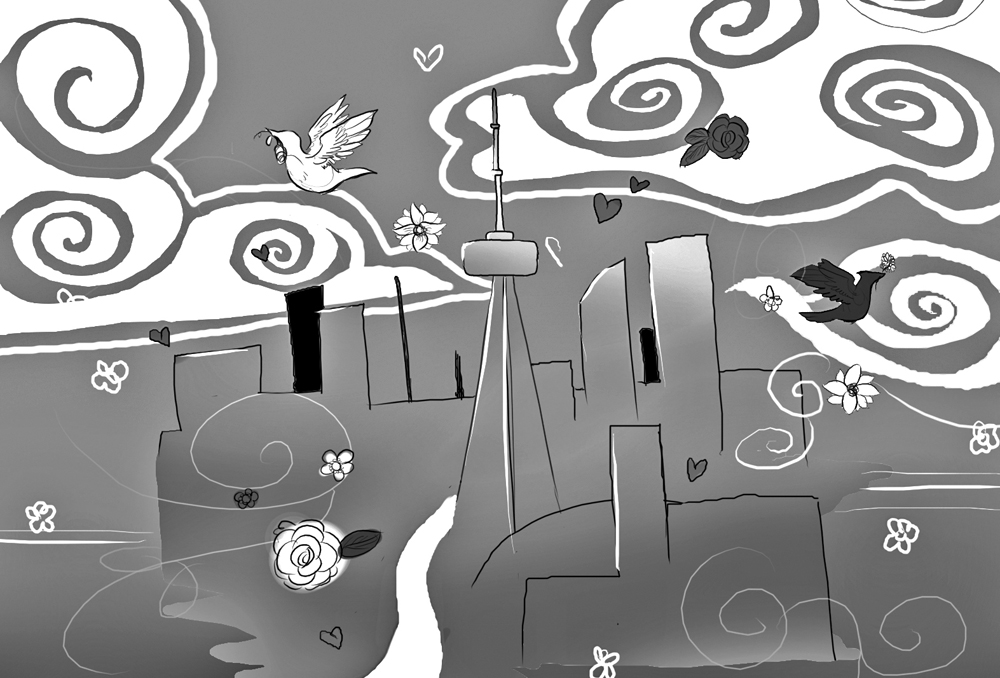Munirul-Haq Raza | Staff Writer
Featured illustration: In 2013, Toronto city council voted to adopt sanctuary city policies, but the realities on the ground are very different. | Jasmine Wiradharma
In less than two months as president, Donald Trump has already upset quite a few people. Recently, President Trump issued an executive order removing federal funding of sanctuary cities, requiring city service workers to report all undocumented users of services.
A sanctuary city usually means a city that welcomes immigrants and refugees by limiting the use of city resources to enforce immigration policies and asking for immigration papers, among other policies to protect undocumented people.
Since Trump’s executive order, there have been increased reports that many refugees, many of whom are from Somalia, Ghana and Djibouti, are walking in freezing temperatures to cross the Canada-U.S. border, in fear of Trump and his policies.
In 1979, Los Angeles became the first self-declared sanctuary city in the United States, where the police adopted a policy to stop officers from profiling people to determine their immigration status.
Toronto became a sanctuary city in 2013, accepting this self-declared status of inclusivity and vowing to protect undocumented people.
The reality on the ground though is very different, according to the report “(No) Access T.O.: A Pilot Study on Sanctuary City Policy in Toronto, Canada,” published by Ryerson University.
Many undocumented migrants living in city shelters experience threats of being reported if they do not leave, and police have been known to check immigration status.
According to a report by Social Planning Toronto in 2013, 30 per cent of agencies have stated that they will share a person’s immigration status with police or immigration officials.
Reports on the total number of undocumented migrants in Canada vary wildly, ranging anywhere between 50,000 to over 100,000.
According to a 2012 City of Toronto report titled “Undocumented Workers in Toronto,” there are many pathways by which an individual can become undocumented. It can be a result of losing a refugee case, or in the case of temporary foreign workers, the loss of their job that also means the loss of status.
Temporary foreign workers have been known to be mistreated by the system, as employers often overlook unsafe working conditions, and fail to provide access to employment insurance, Ontario Works or Ontario Disability Support Programs.
Sanctuary cities exist to provide a basic level of community services to people without confirming their residency status. Without these services, undocumented migrants are forced into unsafe living conditions, always living in fear of being deported.
Critics point out that an overlook of immigration status is an overlook in lawfulness. Toronto Sun columnist Candice Malcolm points out that city councillors are using tax money to provide library services and subsidized housing to non-taxpayers, instead of fixing potholes or issuing building permits to legal taxpayers.
According to Malcolm, democrats see undocumented migrants as victims of a broken system, and manipulate federal immigration laws to protect them. Prime Minister Trudeau is facing a lot of pressure to tackle the influx of undocumented migrants, with Conservative MP Steven Blaney urging Canadian officials to report undocumented migrants to United States authorities.
However, the NDP, along with Amnesty International, the Canadian Council for Refugees and other legal experts, encourage Canada’s acceptance of undocumented migrants from the United States and urge the Trudeau government to scrap the 2004 Safe Third Country Agreement between Canada and the United States.
The agreement states that migrants must apply for asylum in the country they first arrive, essentially prohibiting refugees
from applying for asylum in both the United States and Canada.
When talking about refugees, it is important to remember that human beings are not illegal. If a person loses their immigration status, they do not lose their status —or their basic human right—as a person. Human rights only make sense if they are unconditional and apply to everyone regardless of race, religion or immigration status.



Your compassion is great. but I would clarify a few things. :
“A sanctuary city usually means a city that welcomes immigrants and refugees by limiting the use of city resources to enforce immigration policies and asking for immigration papers, among other policies to protect undocumented people.” you left out the fact that is has to do with people who do not have legal status in the country. a city can be welcoming to immigrants and refugees and provide services to them and not be a sanctuary city for people without legal status.
“Sanctuary cities exist to provide a basic level of community services to people without confirming their residency status. Without these services, undocumented migrants are forced into unsafe living conditions, always living in fear of being deported.” I agree their situation is not good but no one is Canada is forcing anyone to be here without legal status or to do anything.
You also left out the issue of what sanctuary cities become for these people. Prisons. They are afraid to leave the city for fear of being deported. They cannot travel for work or to go home to see family, etc.
We need to offer legal status to these people or get them to leave. Having them stay in the country without legal status in fear and afraid to leave the city is not the solution. Although the intent of the pro-sanctuary city people is good.